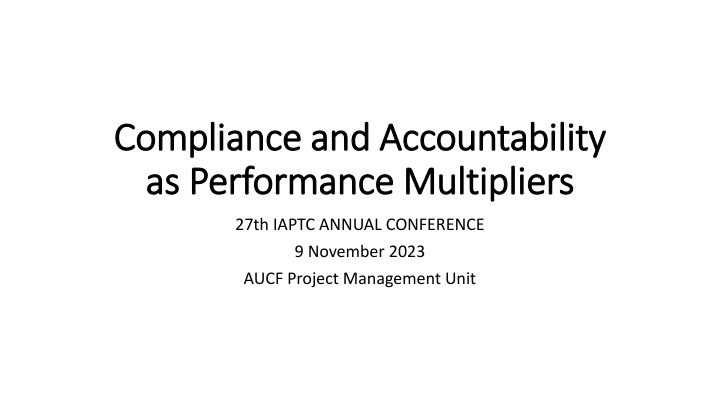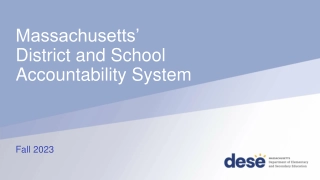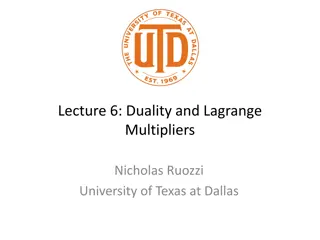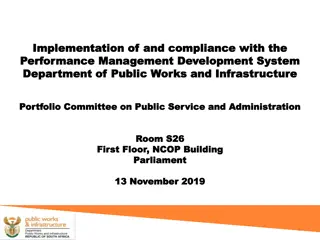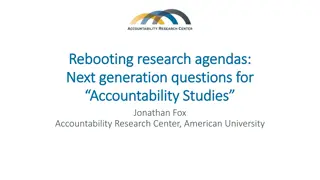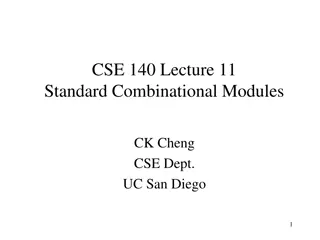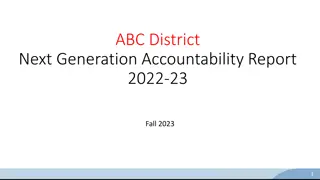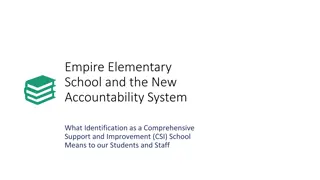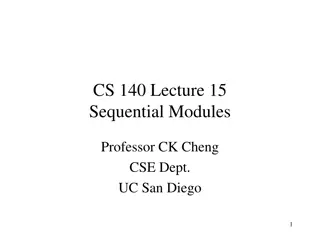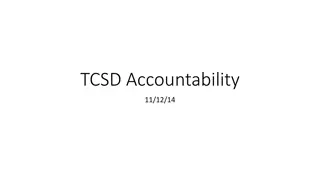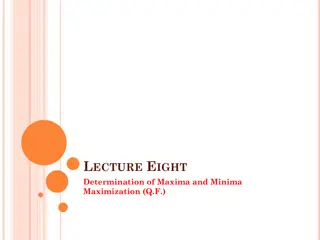Maximizing Accountability for Performance Multipliers
Anchoring human rights at the core of peace enforcement activities enhances operational efficacy. Strong IHRL and IHL compliance set high security standards, promoting trust with local communities and enhancing military objectives accomplishment.
Download Presentation

Please find below an Image/Link to download the presentation.
The content on the website is provided AS IS for your information and personal use only. It may not be sold, licensed, or shared on other websites without obtaining consent from the author.If you encounter any issues during the download, it is possible that the publisher has removed the file from their server.
You are allowed to download the files provided on this website for personal or commercial use, subject to the condition that they are used lawfully. All files are the property of their respective owners.
The content on the website is provided AS IS for your information and personal use only. It may not be sold, licensed, or shared on other websites without obtaining consent from the author.
E N D
Presentation Transcript
Compliance and Compliance and Accountability as Performance as Performance Multipliers Accountability Multipliers 27th IAPTC ANNUAL CONFERENCE 9 November 2023 AUCF Project Management Unit
Scope Scope Genesis of the African Union Compliance Framework Project Foundational elements of the AUCF Compliance Framework Approach Dividends AUCF Strategic Axes AUCF Pillars AUCF Project Achievements Legally-based and performance-based Accountability Monitoring, reporting and Accountability After-action review and Accountability Challenges Way Forward
Genesis and Legal Framework Genesis and Legal Framework Violations of IHL, IHRL, and breaches to applicable standards of Conduct and Discipline in AU PSOs. Protocol Relating to the Establishment of the Peace and Security Council of the African Union (Art. 4; Principle C.) AU Doctrine on PSOs of 2001 (Para. 56, 57 and 58) Kaberuka Report (August 2016): Securing Predictable and Sustainable Financing for Peace in Africa (Annex 3: Towards an Integrated African Union Human Rights and Conduct and Discipline Compliance Framework for African Union Peace Support Operations) AU PSC Communiqu PSC/PR/COMM. (DCLXXXIX) of 30 May 2017 UNSC resolutions 2320 (2016) and 2378 (2017) Joint AU-UN Framework for Enhanced Partnership in Peace and Security (2017) AUC Chairperson and UN SG Joint Communique of December 2018
Foundational Foundational elements elements of the compliance of the compliance framework framework IHL PoC SEA IHRL C&D
Compliance Key Compliance Key Dividends Amid dynamic shifts in the global peace and security architecture, anchoring human rights, including the human rights-based approach, at the heart of the peace enforcement and peacebuilding activities helps to build inclusive processes and implement contextualized, comprehensive and sustainable responses to specific PoC issues, threats, risks. Strong, demonstrable IHRL and IHL compliance sets the highest standards for security forces operating in peace operations and enhances operational efficacy and protection efforts. In this regard, compliance and accountability are key performance enablers. Dividends
Compliance Key Compliance Key Dividends Dividends Compliance with IHRL and IHL helps the force build trust with most of the actors, including the local communities, in the operations environment, which will expedite the accomplishment of its mandated military objectives. A force that is IHRL and IHL compliant also contributes to safeguarding its own reputation and credibility, as well as those of the mandating authority and other relevant partners, including TCEs and TIs. Every violation of IHRL, IHL and case of misconduct damages the image and credibility of the TPCCs, PSO, and the mandating authority, adversely impacts performance and mandate implementation, and causes harm to civilians.
Strategic Axes of the Compliance Framework Strategic Axes of the Compliance Framework Prevention Strategic, operational and tactical instruments Screening and Selection of TP Capacity-building (PDT, IT, IMT) Best Practices and Lessons Learned Assessments Remedial Action Response Protection Mechanisms Monitoring, Tracking and Reporting Mechanisms Ex-Gratia Payment Assistance to Victims Accountability Mechanisms
AUCF AUCF Pillars Pillars 1. Screening and Selection 2. Training 3. Adoption and dissemination of compliance instruments 4. Integration/mainstreaming of IHL, IHRL and PoC requirements in the planning processes and conduct of operations 5. After-Action Review 6. Monitoring and Reporting on violations of IHRL, IHL and breaches to standards of Conduct and Discipline 7. Procedures and Mechanisms to ensure accountability, provide protection, and deliver assistance to victims
Achievements Achievements Capacity-building Seven basic trainings and trainings of trainers for 209 participants, including 42 females, representing ECOWAS and SADC Member States, PSOs personnel, including TPCCs deployed in ATMIS, MNJTF, SAMIM, staff of regional peace training centres and national TCEs/Tis, and Officers of the Somalia National Army in Accra, Gaborone, Kampala, Mogadishu, Nairobi, N Djamena and Pemba; Following engagements with the KAIPTC in Accra, this TCE has taken the lead in mainstreaming compliance and accountability in the peace support operations course for Ghana military academy cadets A draft Training Strategy has been developed, pending review and finalization. Policy development - Adoption of two (2) AU Policies on 1) Screening and Selection of personnel for AUPSOs; 2) Policy on Protection of Civilians (POC) by the African Union Specialized Technical Committee on Defense, Safety, and Security (STCDSS) on 11 May 2023 - Adoption of AU Compliance Strategic Framework Document by the STCDSS on 11 May 2023. - Review of ATMIS Rules of Engagement and Directives on the Use of Force from 17 22 July 2023 - In addition, Drafts of the Communication Strategy and Action Plan have been developed to increase project visibility (pending finalization).
Achievements Achievements Advocacy and engagement - Briefing to AU Human Rights Organs in Lusaka, Zambia, July 2022 - Engagement with the G5 Sahel and MNJTF Leaderships, N Djamena, Chad, 28 November 2 December 2022 - High-level engagements with relevant stakeholders, including UN and AU member states, UNSC members, AU Peace and Security Council Members, to name a few, in Addis Ababa and New York, November- December 2022 - Advocacy meeting with Defense and Military Attach s of Diplomatic Missions in Addis Ababa on the African Union Compliance and Accountability Framework (AUCF) Project, 12 April 2023
Achievements Achievements Advocacy and engagement - Technical Working Session with National Military/Police Training Institutions (TIs) and Training Centres of Excellence (TCEs) in the Economic Communities of West African States (ECOWAS), held at Kofi Annan International Peacekeeping Training Centre (KAIPTC), Accra - Ghana - Engagement and technical working session on the AUCF with representatives of the National Military and Police of SADC Member States and the SADC Regional Peace Training Centre, Gaborone - Botswana - Engagements with RECs/RMs, TCEs and TIs at the ASF 15th Annual Training Implementation Workshop, Cairo - Egypt
Legally Legally- -based based Accountability Accountability and Performance Accountability Accountability and Performance- -based based The AUCF approach combines the legally-based accountability and the performance-based accountability - Legally-based accountability is focused on the alignment with relevant national laws, PSOs policies, strategies, RoE and directives, RECs/RMs compliance instruments, AU relevant policies and guidelines, regional legal instruments including African human rights instruments, and universal legal framework, including IHRL and IHL. This refers to a chain of accountability at different levels (e.g. TPCCs accountability to their respective national institutions, to PSOs management structures, to PSOs mandating authorities, to AU, to UN );
Legally Legally- -based based Accountability Accountability and Performance based based Accountability Accountability and Performance- - - Performance-based accountability refers to the evaluation of the performance of TPCCs or PSOs by their respective governments, mandating authorities (vertical accountability), and by the host country and civilians they have been mandated to protect (horizontal accountability). A dedicated performance system is expected to be developed at the TPCCs and PSO levels Accountability and the possibility for the beneficiaries to assess the quality of the service delivered by PSOs based on objective criteria are powerful multipliers of performance. This form of accountability requires inclusivity, i.e. transparency, information sharing, and participation of relevant actors in processes that aim at addressing issues affecting their lives, protection, rights, and welfare.
Monitoring, Monitoring, Reporting Strong linkages between Pillars 6 and 7 - Importance of monitoring, investigation, and reporting in ensuring accountability for violations of IHRL and IHL, and misconduct: Deployment of monitoring, investigation and reporting capacities embedded in PSOs and ; Operationalisation of relevant tools such as the CCTARC or the Case Management System to document, track cases, and develop relevant analyses on trends and patterns of violations of IHRL, IHL, and cases of misconduct; Information gathering through monitoring and investigation allows the building of cases and subsequent actions to provide appropriate responses; Operationalization of a data base to record violations and follow up on response and remedial actions. Reporting and and Accountability Accountability
After After- -Action Action Review Review and performance and performance improvement improvement Crucial to identify gaps between planning and effective conduct of operations, shortfalls in the measures taken to prevent collateral damages, including harm to civilians; Brainstorming sessions on possibilities to improve the performance of the relevant components in planning and conducting operations, including the mainstreaming of IHRL and IHL in all relevant measures to protect civilians. Identification of lessons and best practices that will inform further actions and inspire other actors involved in similar experience or operating in the same context.
Challenges Challenges Implementing a continent-large scale project is not easy in terms of networking and coordinating the numerous actors involved in the project implementation; Lack of widespread awareness of the AUCF; Lack of participation of non-State actors, particularly NHRIs and Civil Society Organisations; Uncertainty about the duration of the AU PSOs and the AUCF project does not allow mid and long-term projection; Getting the effective political buy-in and commitment of the TPCCs and RECs to operationalize the AUCF remains a challenge;
Challenges Challenges Perception of IHRL and IHL as obstacles to military performance in a context of asymmetric war; Lack of appropriate financial and human resources, including dedicated staff to oversee the AUCF operationalization at the PSOs level. Lack of integrated information management system Disparate pieces of accountability and performance system Difficult coordination between the national, sub-regional, and regional levels Insufficient collaboration between relevant stakeholders involved with responsibilities in contributing performance, including PSOs, Host Countries Governments, CSOs, communities to accountability and
WAY FORWARD WAY FORWARD Intensive discussions with RECs, PSOs, TPCCs on the development of procedures and establishment accountability and improve performance. Continue to raise awareness of existing policies, guidelines, directives, SOPs and mechanisms during pre-deployment, induction and in- mission training (Critical role of TCEs/Tis and Mission Training Units). Set up a system to evaluate the progress towards more compliance by developing a set of deliverables, standards, benchmarks, and indicators, as well as a clear methodology guiding the exercise. of mechanisms to strengthen
Way Way Forward Forward Beyond the ongoing work of design and operationalization of a Case Management System, refine a broader information management system able to connect the dots between the national, sub-regional, PSO and regional levels in terms of information flow, management and data generation. There is no evaluation, no accountability and no performance improvement without a reliable and transparent information and data management system. Develop an approach that enables dedicated engagement and tailored support to address underperformance and incentives and recognition to encourage outstanding performance or particular best practices (Compliance championship initiative). Enhance efforts to ensure comprehensive and effective remedial action, beyond the existing ex-gratia payment.
FINAL WORD FINAL WORD Considering that challenges can be overcome with a strong will, appropriate resources, and consistent commitment, the final word is that the AUCF project is a gold mine for the AU, RECs and TPCCs as well as other relevant stakeholders, including TCEs and Tis, and an opportunity to sustain peace and security initiatives in the fast- changing African and international environments. THANKS FOR YOUR ATTENTION
